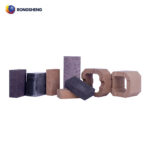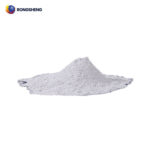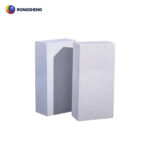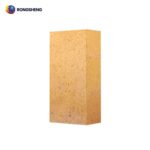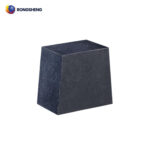![]()
Insulation Silicon Corundum Brick
- wear resistance and erosion resistance.
- Good thermal shock stability,
- Anti-cracking and Anti-peeling.
- Extend their service life.
We are Here to Help!
Email: sales@hy-refractory.com
WhatsApp: +86 185 3831 2977
Rongsheng Insulation Silicon Corundum Brick for Sale. In order to meet the requirements of large and medium-sized rotary kilns and other thermal equipment in the cement, metallurgy, lime and other product industries in areas or parts with large temperature changes, high erosion, high wear, and high erosion, silica corundum bricks came into being. As a “long-lasting energy-saving” product in the transition zone of rotary kilns, thermal insulation silicon corundum bricks have become the first choice for transition zones and decomposition zones of large and medium-sized rotary kilns with new technology and excellent quality.
Raw Material Composition of Thermal Insulation Silicon Corundum Brick
Thermal insulation silicon corundum bricks use black corundum and special grade mullite as basic materials, silicon carbide and zircon as auxiliary materials, and add additives and composite binders to form high pressure. The special process of high-temperature sintering in a semi-reducing atmosphere makes the products have higher wear resistance and thermal shock resistance. Compared with spinel bricks and silica bricks, it has the quality and advantages of long-term energy saving. In addition, the insulating silicon corundum bricks are embedded with a certain thickness of high-temperature ceramic fiber board on the non-working surface. On the basis of retaining sufficient strength without affecting the service life, the overall thermal conductivity is greatly reduced, which effectively blocks a large amount of heat transfer to the cylinder. It not only protects the barrel equipment, but also reduces the load of the equipment, reduces coal consumption, and improves the effective utilization rate of heat energy.
Performance Characteristics of Thermal Insulation Silicon Corundum Brick
Silica corundum brick is a product used in the transition zone and cooling zone of large and medium-sized rotary kilns in cement, lime and other building materials industries. Its characteristic is to embed a specified area of thermal insulation material on the cold surface of the silica corundum brick. The thermal conductivity of the insulation material at 500°C is only 0.11W/(m·k), which can effectively prevent the transfer of insulation. Insulating silicon corundum brick is a high-grade refractory material that integrates many advantages such as high strength, erosion resistance, good corrosion resistance, superior thermal shock stability, and energy saving. It can effectively reduce the number of inspections and repairs, extend the service cycle, and reduce the temperature of the cylinder above 50°C. Protect the safe operation of thermal equipment.
Performance Advantages of Thermal Insulation Silicon Corundum Bricks
- Improve the strength, wear resistance and erosion resistance of the original products and extend their service life.
- Improve the thermal shock stability of the product and overcome the phenomenon of lining brick cracking and peeling.
- Adjust the product line change rate. Make it adhere tightly to the equipment to avoid loosening of lining bricks and brick falling.
Comparison of Physical and Chemical Properties of Thermal Insulation Silicon Corundum Bricks and Other Products
The heat-insulating silicon corundum bricks have better wear resistance, heat shock resistance and thermal conductivity than spinel bricks.
As an improved alkaline material, spinel brick inherits the characteristics of alkaline products with high softness and good corrosion resistance. Relatively improved compressive strength, but at the same time there are the shortcomings of poor thermal shock, high thermal conductivity and obvious insufficient wear resistance. The strength of the thermal insulation silica corundum brick is 1.5 to 2 times that of the spinel brick, the number of thermal shocks (water-cooled at 1100°C) is 2 to 3 times that of the spinel brick, and the thermal conductivity is more than 1 times lower than that of the spinel brick. Excellent physical indicators fundamentally change the working environment of the rotary kiln during operation.
Table1 Comparison of physical and chemical properties of thermal insulation silicon corundum bricks and other products
| Items | Refractoriness under load (T0.6·℃) |
Thermal conductivity (1100℃) W/m·k |
Cold Compressive Strength (MPa) |
Thermal Shock Resistance 1100℃, Water Quenching (Cycle) |
Take the 5000T/D production line as an example, the reference service life of the transition zone (Months) |
| Insulation Silicon Corundum Bricks | ≥1660℃ | Hot ≤1.8 Cold ≤0.2 |
110-150 | 20-25 | 12-24 |
| Spinel Bricks | ≥1700℃ | 3.0 | 50-70 | 4-12 | 10-12 |
| Silica-Mullite Red Bricks | ≥1650℃ | ≤1.8 | 90-110 | 15-20 | 10-16 |
| High Wear-Resistant Composite Brick | ≥1400℃ | Hot ≤1.8 Cold ≤1.5 |
60-80 | 20-25 | 6-8 |
Analysis of the Physical and Chemical Properties of Thermal Insulation Silicon Corundum Bricks
First of all, higher compressive strength is an important factor in resisting the operating stress of the rotary kiln. In the process of starting and stopping the kiln, the shearing force has a huge impact on the product, and it is easy to squeeze the lining product that works under high temperature to cause its fracture or even the brick to collapse, which causes the loss of the company’s production shutdown and repair. At the same time, the level of compressive strength is also an important factor in judging the wear resistance. The higher the strength, the better the wear resistance. As the main materials of heat-insulating silicon corundum products, corundum and silicon carbide are both highly wear-resistant materials, and the synthesized and calcined products have excellent high wear resistance. The amount of abrasion is much lower than that of alkaline products (according to the national standard “GB/T 18301-2001”, the amount of abrasion per unit time tested for insulating silicon corundum products is less than 3.2cc).
Secondly, excellent thermal shock stability is a major feature of thermal insulation silicon corundum bricks. The thermal insulation silicon corundum brick is not easy to peel off and burst under high temperature. The lower porosity not only comes from the gradation structure of the product itself but also from the sealing of the visible pores on the glaze surface formed by the product at high temperature. This glaze not only hinders the penetration and damage of harmful gases to the product but also increases the toughness of the product to a certain extent. Observing the remaining bricks, it can be found that the harmful penetration of spinel bricks is generally 20mm, while the penetration of insulating silica corundum bricks does not exceed 5mm. In other words, the thickness of each spinel brick peeling layer is generally 2-3 cm. The heat-insulating silicon corundum bricks will not peel off layer by layer, but will only reduce the height of the product a little bit in the flat wear.
Next, in terms of reducing heat loss, insulating silicon corundum bricks have irreplaceable quality. The thermal conductivity of alkaline products is high, which is very obvious in the relatively neutral materials of refractory products. It is the main factor of heat loss and the main reason for the deformation of the rotary kiln caused by the red kiln. “Long-term energy saving” is first to ensure the efficiency of heat energy use, reduce heat emissions, prevent the loss of insulation, and thus reduce fuel consumption. Insulating silicon corundum bricks not only have the lower thermal conductivity of neutral materials, but the high-temperature ceramic fiber board forms a thermal insulation layer between the lining material and the cylinder. Its thermal conductivity is less than 0.1w/m·k, making it an excellent high-temperature insulation material. It provides an important guarantee for energy saving and consumption reduction.
In addition, good volume stability is also a significant feature of thermal insulation silicon corundum bricks. Due to the large expansion coefficient of alkaline products, the thermal stress at high temperatures can easily cause the products to squeeze each other and cause the fried head to peel off. The thermal insulation silicon corundum brick has a relatively small expansion coefficient, and its volume is stable at high temperatures without reducing the strength of use, which enhances erosion resistance and wear resistance.
At the same time, moderate density is also an unforgettable condition for the choice of rotary kiln lining. Compared with the thermal insulation silicon corundum products, the specific gravity of alkaline products differs by 10% (spinel 3.0, thermal insulation silicon jade brick 2.7). That is to say, with the same volume of inner lining, heat-insulating silicon corundum bricks are 10% less weight than spinel bricks, which also reduces the equipment load.
Rongsheng Refractory Brick Manufacturer
Rongsheng is an experienced refractory brick manufacturer and sales company. Rongsheng’s refractory products have been sold to more than 60 countries and regions all over the world. For example, Vietnam, Laos, Thailand, Malaysia, Singapore, Indonesia, Philippines, Turkey, Kuwait, South Africa, Egypt, Russia Uzbekistan, etc. We have rich experience in the production and design of cement rotary kiln lining materials. Our R&D and design team can provide refractory lining materials that best suit your production needs for a variety of different lining needs. It not only greatly improves your production needs, but also saves you production costs to the utmost extent. For more price information about refractory brick products, such as magnesia bricks, magnesia-spinel bricks, etc. please contact Rongsheng. We will provide you with services according to your specific needs.

